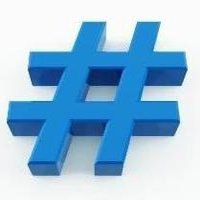Highlights of Contents
Early origins
The hash in the hashtag for friends refers to this symbol # and until recently almost everyone living in North America will have known it by another name – the pound sign. Over in the UK, however, labeled to the hash in order to avoid confusion with the symbol £ which is used to denote pounds sterling, the nation’s currency.
Quite how # came to be known as the pound sign isn’t clear – some argue that it was used to denote the weight of goods in the unit pounds, although there are very few examples of it being employed in this manner.
However, it’s clear that most North Americans were, for much of the 20th Century, familiar with it being employed to replace the word number. For example, #2 would be read as “number two”.
Technology makes it mark
The pound sign became better know with the advent of touchtone phones and automated services. Not only was the key found on any such device, people were regularly asked to use it in order to navigate pre-recorded call-routing menus. “Please input your account number followed by the pound key” is a message you’re still likely to hear today.
Given that the UK never really adopted # as an abbreviation for “number” it seems likely that it was the introduction of the touchtone phone that led to the then unfamiliar symbol being christened the hash.
The rise of the internet
The casual observer would be forgiven for believing the hashtag for friends started with Twitter, but it was actually in use long before most people were even aware of the existence of the internet.
Internet Relay Chat, a service created in 1988, was the birthplace of the hashtag as we know it today. As with Twitter, the # symbol was used to group messages of a similar nature, and it’s likely that this is where the micro-blogging site got its inspiration from.
Not that Twitter itself thought of the hashtag – it was actually a user of the service who came up with the idea.
On August 23rd, 2007, Chris Messina tweeted “How do you feel about using # (pound) for groups As in #barcamp [msg]?” and the hashtag was born.
The first recorded use of the word hashtag came roughly a year later, and as Twitter itself grew in popularity, so did the habit of putting # before a collection of words.
Changing times for the Twitter hashtag for friends
Clicking on a hashtag still shows all the tweets which included that particular tag, but it’s not as important a feature as it was when Twitter’s search capabilities left a lot to be desired.
Twitter’s improved search capabilities mean that people can find topics that interested them without the use of a hashtag and so its usage has transformed somewhat.
Users are now increasingly likely to employ the hashtag as a sort of PS which adds extra context to their message, rather than to use one to categorize their tweet.
However, the original use of the hashtag can still be seen on a regular basis. Often, people will use one when they are taking part in a trending meme as this increases the visibility of their message and lets people know that they’re doing.
Those attending events will also employ a hashtag as they live-tweet proceedings, allowing others to see what is going on, while big news stories often get the same treatment.
What will the hashtag for friends bring to Facebook?
On the face of it, the hashtag doesn’t seem to sit well with Facebook as the social media site is much more of a closed platform than Twitter. Most users of the Micro-blogging platform are happy to share everything with everyone, while on Facebook privacy concerns mean people are more guarded with their platforms.
However, Facebook looks set to use a hashtag for friends in order to boost its advertising efforts, something which Twitter has also done.
Whether this works remains to be seen, but it looks like the hashtag won’t be going away anytime soon.
Guest article by Will Stevens, part of the 123-reg.co.uk blogging and social team. The company is the UK’s largest domain name registrar.
